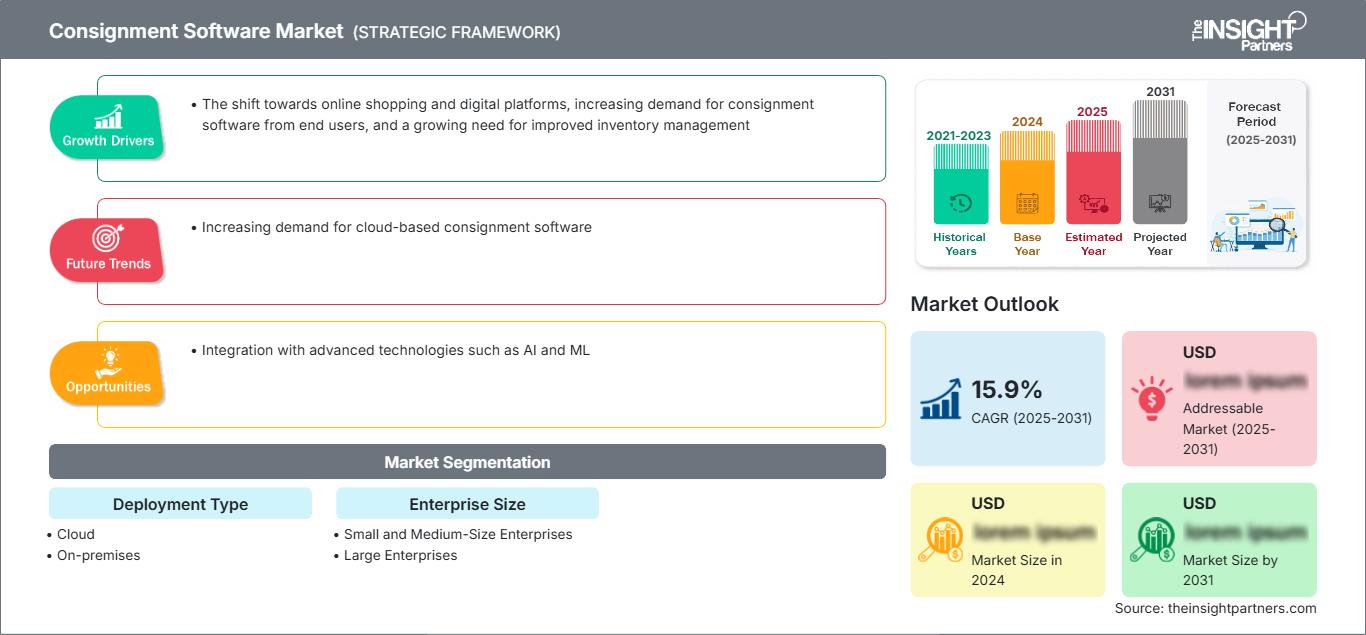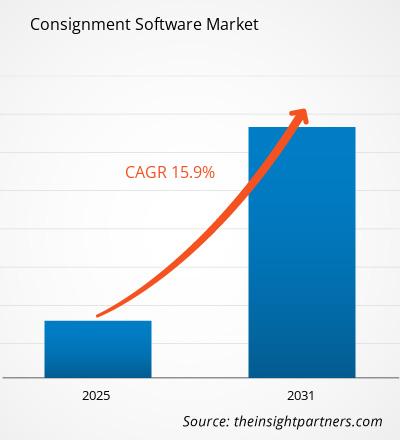Si prevede che il mercato del software di spedizione registrerà un CAGR del 15,9% nel periodo 2023-2031. L'integrazione con tecnologie avanzate come l'intelligenza artificiale e l'apprendimento automatico (ML) è destinata a rimanere una tendenza chiave nel mercato.
Analisi del mercato del software per la spedizione
- Il mercato del software per la spedizione include prospettive di crescita dovute alle attuali tendenze del mercato e al loro impatto prevedibile durante il periodo di previsione.
- Il mercato del software per la spedizione è in crescita a causa di fattori quali il passaggio allo shopping online e alle piattaforme digitali, la crescente domanda di software per la spedizione da parte degli utenti finali e la crescente necessità di una migliore gestione dell'inventario.
- La crescente domanda di software per la spedizione basato su cloud offre opportunità redditizie per il mercato del software per la spedizione.
Panoramica del mercato del software per la spedizione
- Il software per la spedizione è un software progettato per supportare il settore della rivendita, inclusi i negozi in conto vendita, i negozi dell'usato, i centri commerciali e i negozi di rivendita.
- Il software per la spedizione facilita la gestione senza sforzo delle attività basate sulla spedizione.
- Il software per la spedizione automatizza le vendite Monitoraggio, liquidazioni e rendicontazione finanziaria, che gestiscono entrate e spese. La comunicazione in tempo reale con i mittenti garantisce transazioni fluide, riscossione dei pagamenti e gestione di resi o cambi, contribuendo a migliorare il servizio clienti.
Personalizza questo rapporto in base alle tue esigenze
Potrai personalizzare gratuitamente qualsiasi rapporto, comprese parti di questo rapporto, o analisi a livello di paese, pacchetto dati Excel, oltre a usufruire di grandi offerte e sconti per start-up e università
Mercato del software di spedizione: Approfondimenti strategici

- Ottieni le principali tendenze chiave del mercato di questo rapporto.Questo campione GRATUITO includerà l'analisi dei dati, che vanno dalle tendenze di mercato alle stime e alle previsioni.
Driver e opportunità del mercato dei software per la spedizione in conto vendita: spostamento verso lo shopping online e le piattaforme digitali per favorire il mercato
Potrai personalizzare gratuitamente qualsiasi rapporto, comprese parti di questo rapporto, o analisi a livello di paese, pacchetto dati Excel, oltre a usufruire di grandi offerte e sconti per start-up e università
Mercato del software di spedizione: Approfondimenti strategici

- Ottieni le principali tendenze chiave del mercato di questo rapporto.Questo campione GRATUITO includerà l'analisi dei dati, che vanno dalle tendenze di mercato alle stime e alle previsioni.
- Con l'aumento del commercio mondiale online, gli operatori del mercato al dettaglio, dai negozianti ai fornitori, stanno gradualmente adottando soluzioni digitali.
- Lo shopping online ha rivoluzionato il settore della vendita al dettaglio, trasformando il modo in cui i consumatori acquistano e le aziende operano.
- Lo shopping online è diventato sempre più popolare e conveniente grazie all'enorme crescita del settore dell'e-commerce e ai progressi tecnologici.
- Secondo Retyp, LLC, nel 2022 negli Stati Uniti c'erano 268 milioni di acquirenti online. Si prevede che questo numero aumenterà a quasi 285 milioni di acquirenti online nel 2031. Inoltre, si stima che nel 2024 ci saranno tra 12 e 24 milioni di negozi di e-commerce a livello globale.
- Pertanto, questo spostamento verso lo shopping online e le piattaforme digitali guida il mercato dei software per la spedizione in conto vendita. crescita.
Crescente domanda di software di spedizione basato su cloud
- Il software di spedizione basato su cloud offre una maggiore accessibilità, consentendo ai proprietari di negozi e al personale di gestire i dati di inventario e vendite da qualsiasi luogo con una connessione Internet.
- Il software di spedizione basato su cloud è più accessibile ai negozi più piccoli e alle startup grazie al modello di soluzioni cloud basato su abbonamento, che aumenta anche la potenziale base di utenti del software riducendo le spese iniziali.
- Migliori capacità di integrazione con piattaforme di e-commerce e processori di pagamento offrono soluzioni più complete, mentre la scalabilità e gli aggiornamenti automatici riducono gli oneri IT.
- È probabile che il passaggio a soluzioni basate su cloud determini una crescita sostanziale nel mercato del software di spedizione, poiché le aziende riconoscono sempre più i vantaggi di queste piattaforme moderne, flessibili e ricche di funzionalità.
Analisi della segmentazione del rapporto di mercato del software di spedizione
I segmenti chiave che hanno contribuito alla derivazione dell'analisi di mercato del software di spedizione sono il tipo di distribuzione e l'azienda dimensione.
- In base al tipo di distribuzione, il mercato è suddiviso in cloud e on-premise.
- In base alle dimensioni aziendali, il mercato è suddiviso in piccole e medie imprese e grandi imprese.
Analisi della quota di mercato del software di spedizione per area geografica
- Il rapporto sul mercato del software di spedizione comprende un'analisi dettagliata di cinque principali regioni geografiche, che include le dimensioni attuali e storiche del mercato e le previsioni per il periodo 2021-2031, coprendo Nord America, Europa, Asia-Pacifico (APAC), Medio Oriente e Africa (MEA) e Sud e Centro America.
- Ogni regione è ulteriormente suddivisa nei rispettivi paesi. Questo rapporto fornisce analisi e previsioni di oltre 18 paesi, coprendo le dinamiche del mercato del software di spedizione, come fattori trainanti, tendenze e opportunità che influenzano i mercati a livello regionale.
- Inoltre, il rapporto copre l'analisi PEST, che prevede lo studio dei principali fattori che influenzano il mercato del software di spedizione in queste regioni.
Mercato del software di spedizione
Le tendenze regionali e i fattori che influenzano il mercato del software per la spedizione in conto vendita durante il periodo di previsione sono stati ampiamente spiegati dagli analisti di The Insight Partners. Questa sezione analizza anche i segmenti e la geografia del mercato del software per la spedizione in Nord America, Europa, Asia-Pacifico, Medio Oriente e Africa, America Meridionale e Centrale.
Ambito del rapporto di mercato del software di spedizione
| Attributo del rapporto | Dettagli |
|---|---|
| Dimensioni del mercato in 2024 | US$ XX million |
| Dimensioni del mercato per 2031 | US$ XX Million |
| CAGR globale (2025 - 2031) | 15.9% |
| Dati storici | 2021-2023 |
| Periodo di previsione | 2025-2031 |
| Segmenti coperti |
By Tipo di distribuzione
|
| Regioni e paesi coperti | Nord America
|
| Leader di mercato e profili aziendali chiave |
|
Densità degli operatori del mercato del software di spedizione: comprendere il suo impatto sulle dinamiche aziendali
Il mercato del software per la spedizione in conto vendita è in rapida crescita, trainato dalla crescente domanda degli utenti finali, dovuta a fattori quali l'evoluzione delle preferenze dei consumatori, i progressi tecnologici e una maggiore consapevolezza dei vantaggi del prodotto. Con l'aumento della domanda, le aziende stanno ampliando la propria offerta, innovando per soddisfare le esigenze dei consumatori e sfruttando le tendenze emergenti, alimentando ulteriormente la crescita del mercato.

- Ottieni il Mercato del software di spedizione Panoramica dei principali attori chiave
Il mercato dei software per la consegna in conto vendita viene valutato raccogliendo dati qualitativi e quantitativi a seguito di ricerche primarie e secondarie, che includono importanti pubblicazioni aziendali, dati di associazioni e database. Di seguito sono elencati alcuni degli sviluppi nel mercato dei software per la consegna in conto vendita:
- Entrupy collabora con Consign Cloud. ConsignCloud offre funzionalità pensate per semplificare proprio questo aspetto: semplificare i processi di inventario, ottimizzare la categorizzazione e garantire un'esperienza più fluida ed efficiente per gli esperti di rivendita in negozio. Entropy, invece, garantisce che il negozio sia rifornito con i prodotti giusti. (Entrupy, Comunicati stampa, febbraio 2024)
- mymediset, fornitore leader di soluzioni SAP per il settore dei dispositivi medici, e Terso Solutions, fornitore leader di soluzioni di tracciamento RFID per i mercati delle scienze biologiche e dell'assistenza sanitaria, hanno annunciato oggi una nuova partnership per il lancio di mymediset LiveSync. Questa piattaforma rivoluzionaria trasformerà il modo in cui l'inventario in conto deposito viene identificato, gestito e tracciato nelle catene di fornitura mission-critical in tutto il mondo. (Mediaset, Comunicati stampa, marzo 2024)
Copertura e risultati del rapporto sul mercato del software per la consegna
Dimensioni e previsioni del mercato del software per la consegna (2021-2031) Il rapporto fornisce un'analisi dettagliata del mercato che copre le seguenti aree:
- Dimensioni e previsioni del mercato del software di spedizione a livello globale, regionale e nazionale per tutti i segmenti di mercato chiave coperti dall'ambito
- Tendenze del mercato del software di spedizione, nonché dinamiche di mercato come fattori trainanti, vincoli e opportunità chiave
- Analisi dettagliata delle cinque forze PEST/Porter e SWOT
- Analisi del mercato del software di spedizione che copre le principali tendenze del mercato, il quadro globale e regionale, i principali attori, le normative e i recenti sviluppi del mercato
- Analisi del panorama del settore e della concorrenza che copre la concentrazione del mercato, l'analisi della mappa termica, i principali attori e i recenti sviluppi per il mercato del software di spedizione
- Profili aziendali dettagliati
- Analisi storica (2 anni), anno base, previsione (7 anni) con CAGR
- Analisi PEST e SWOT
- Valore/volume delle dimensioni del mercato - Globale, Regionale, Nazionale
- Industria e panorama competitivo
- Set di dati Excel
Report recenti
Rapporti correlati
Testimonianze
Motivo dell'acquisto
- Processo decisionale informato
- Comprensione delle dinamiche di mercato
- Analisi competitiva
- Analisi dei clienti
- Previsioni di mercato
- Mitigazione del rischio
- Pianificazione strategica
- Giustificazione degli investimenti
- Identificazione dei mercati emergenti
- Miglioramento delle strategie di marketing
- Aumento dell'efficienza operativa
- Allineamento alle tendenze normative




















 Ottieni un campione gratuito per - Mercato del software di spedizione
Ottieni un campione gratuito per - Mercato del software di spedizione